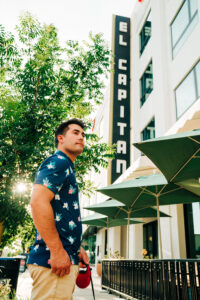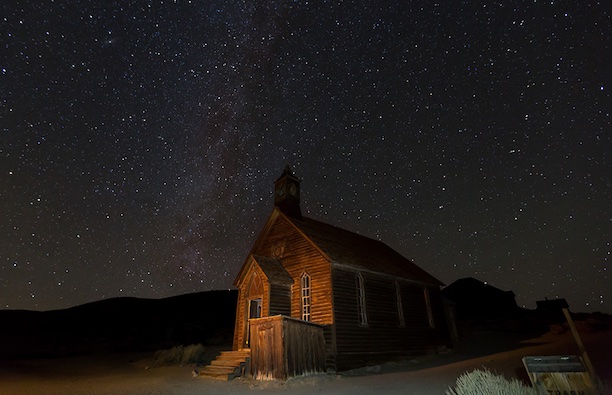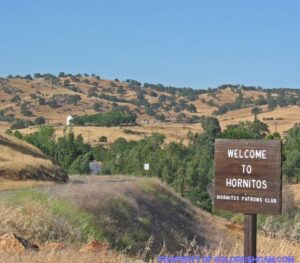
It has recently been claimed that what was once historic is now surfacing for many travelers of a certain age as “HIPstoric.” And as enthusiastic travelers search for more colorful journeys, they need to look no further than the Golden State, where they can strike gold in the three historically-rich and Yosemite-adjacent towns of Merced, Bodie and Hornitos.
Here’s a look at this “HIPstoric” California adventure to these unique destinations, with a few golden nuggets, too.
Merced CA Things To Do, Hotels & Restaurants

Initially, the Central Valley wasn’t considered useful land, and was often overlooked in favor of coastal California. That is, until all that gold was rushing through the Sierras, and miners from around the world followed. Despite coming across what are now known as the San Joaquin River and the River of Our Lady of Mercy, Lieutenant-General Gabriel Moraga was in search of land suitable for a mission, but he was unimpressed with the conditions in the valley, saying “The area was totally unfit for farming.”
That was in 1806. It wasn’t long before the Gold Rush made its impact on California’s resources and the vast lands of greater Merced became the gold standard for everything from livestock to produce. Flocks of sheep, numbering in the thousands, were herded from New Mexico and cattle by the thousands were also herded in and then turned loose to graze.
Then, came wheat in the 1850s, which yielded approximately 113,000 bushels, then by 1874, the Valley was producing 7½ million bushels of wheat. This was the beginning. The decades that followed were a chronology of families and whole communities, including the Portuguese, the Japanese, and the Swedes, that migrated to the county to work the soil.
The heritage of Merced County is not a history of great battles and gallant generals nor artifacts and ghost towns. It is a story of industrious pioneers who were seeking good land to raise their families and the land was good to them. As a result of this robust farming history, Chef Quentin Garcia of the highly-acclaimed Rainbird Restaurant celebrates the farms and farmers of its Central Valley home, reveling in the bounty of rich harvest.
Where to Stay:
El Capitan Hotel. Built in 1872, adjacent to the railroad tracks for passengers enroute to Yosemite, this elegantly historic hotel went through two renovations, being rebuilt in 1912 from its original four-story frame to the 2021 renovation, expanding the hotel from 90 rooms to 144 guest rooms and suites.
Where to Dine:
• Rainbird Restaurant
The Rainbird is located in the El Capitan Hotel.
Points of interest:
• Merced Historical Society and the County Courthouse
The museum houses 8,500 square feet of exhibits, both permanent and rotating, which depict the history of Merced County as well as the settlers of the Great Central Valley. Located in the county’s three-story courthouse built in 1875, it is one of the oldest historical buildings in California.
• Castle Air Museum
Home to more than 80 restored vintage military aircraft ranging from pre-WWII to the present-day fighters, the Museum houses a fascinating collection of wartime memorabilia, uniforms, historic photos, and personal military artifacts from the past century.
• Multicultural Art Center – aka The MAC
This is where local art and artisans are the focus.
• The Tioga
Steps from El Capitan and Mainzer Theater, take a stroll past this iconic 1928-era hotel, which is now a beautifully-restored, private residence.
• The Merced Theater
Opened on October 31st, 1931 with the world premiere of Local Boy Makes Good staring Joe E. Brown, the theater continues to serve the Merced community with concerts, theater productions, and special events. The Tower is the most recognized landmark in Merced.
• Mainzer
Standing proudly in the center of town, this 100+ year old theater has been artfully renovated to showcase the theater’s historic architectural features. Casual fare, shows and old-school entertainment are served up here.
Mono County’s Bodie State Park Things To Do, Restaurants & Hotels

In Mono County, visitors will want to stroll about Bodie State Historic Park, which is claimed as “the most authentic way to see the real-life setting of the California gold rush.” From 1877 to 1882, Bodie was a bustling town with close to 8,000 residents and produced more than $38 million in gold and silver.
Today, with the gold mining days of California’s past as a distinct memory, there are almost 200 abandoned wooden buildings in a state of “arrested decay” to photograph and explore. Visitors can peek in the windows of the church, schoolhouse, barbershop and saloon, where bottles, desks and other relics remain today.
The Bodie Foundation’s Mercantile store in nearby Bridgeport features souvenirs and more enrichment on Bodie’s significant past as a preserved ghost town, maintaining the same character from when the last residents left 50 years ago. As a result, there are no hostelries nor commercial facilities, however, the nearby town of
Where to Stay:
Bridgeport Inn – The historic inn, built in 1877, is conveniently located on Highway 395.
Bodie Hotel – Relocated from nearby Bodie ghost town, over 140 years ago, this boutique, 7-room hotel features vintage appointments in the dramatic Victorian setting.
Double Eagle Resort – This four-season resort and spa is conveniently located in nearby June Lake.
Where to Dine:
• The Tioga Lodge Restaurant
Located in the historic building moved from Bodie State Historic Park, on the shore of Mono Lake just off highway 395.
• Bridgeport Inn
Breakfast Lunch & Dinner – Serving Harris Ranch Steaks.
• Growler’s Eatery
The place for epic BBQ.
• Virginia Creek Settlement
Hearty fare for breakfast, lunch and dinner.
Points of Interest:
Bodie State Historic Park – A genuine California gold-mining town, where visitors can walk down the deserted streets of a town that once had a population of nearly 10,000 people.
Mono Basin Historical Society & Museum – Featuring artifacts, historic photographs, and equipment chronicling the mining and pioneering history of the Mono Basin, Bodie, and Lundy, the museum showcases a fine collection of Kutzadikaa (Paiute) baskets and tools. Outdoor exhibits include farming and mining equipment, and Nellie Bly O’Bryan’s world-famous Upside Down House.
Mariposa CA Hornitos Ghost Town Things To Do, Restaurants & Hotels

Whether or not you believe in apparitions from the Wild West or not, Mariposa’s small town of Hornitos holds the mystery of a legendary ghost town.
There are no banks or office buildings, no strip malls touting tired brands or bright lights obscuring the night sky. Instead, with a population hovering at about a meager 50 residents, Hornitos isn’t technically a ghost town, yet curious visitors can still mingle with the avenging spirit of bandit-hero Joaquin Murrieta simply by walking through the main plaza and its spectral array of age-old buildings towered over by an infamous hilltop cemetery.
Hornitos challenges today’s tourists to imagine that in 1870 it was the center of a thriving district and home to a population of over 10,000, which was originally populated by enterprising gold miners during the Gold Rush.
Where to Stay:
El Capitan. Built in 1872, adjacent to the railroad tracks for passengers enroute to Yosemite, this elegantly historic hotel went through two renovations, being rebuilt in 1912 from its original four-story frame to the 2021 renovation, expanding the hotel from 90 rooms to 144 guest rooms and suites.
Where to Dine:
Pack a lunch or, better yet, take advantage of El Capitan Hotel’s Yeti Day Trip Offer for a day trip to Hornitos, complete with a Yeti cooler that guests can fill up with provisions from the hotel’s Native Son.
Points of Interest:
Architectural ruins and historic markers – a comprehensive guide to all the historic points of interest, including Historic Jail Museum, Indian Gulch, Saint Catherine Catholic Church, The Ghirardelli Store, Old Wells Fargo Office (circa 1854), and many others.
And for the proverbial “icing on the cake,” the California wildflowers will likely be amazing this season and into summer due to all the rain we’ve seen here in California this winter. So, whether visitors are basking in history or they’re more inclined to take in all of nature’s gifts — the flowers, fauna, waterfalls, and harvests will be eager to greet those from within the state and beyond.
Molly Blaisdell is a freelance travel and culture journalist who is a contributing producer for NPR’s “Journeys of Discovery with Tom Wilmer.”
Leave a Reply
You must be logged in to post a comment.